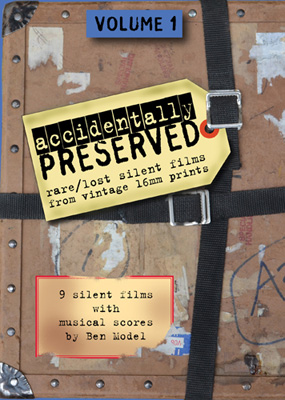Prints of rare and lost films turn up in odd places. A distant cousin in Queens, removed a few times and older than my folks, had a large collection of 16mm silents that I wound up with after he passed away. Mostly old 3rd- or 4th gen dupes of Chaplin shorts, but a few gems — among them, three razor sharp Ko-ko the Clown shorts.
One of them was what I’ll call a dead print. The print of Toot Toot (1926) was an unprojectable octagonal brick when I got it, reeking of vinegar. However, the prints of Mechinical Doll (1922) and The Fade-Away (1925) were still projectable, albeit also diagnosed with safety film’s terminal illness “vinegar syndrome”.
What was remarkable about these two prints, and I’ll assume the same for the dead one, is that their head and tail leaders had pen-and-ink handwriting on them labeling them as being from (or for) Astor Pictures. Additionally, upon examining the the prints, small and very thin notches had been sliced out at different places. These would have been indications for whoever was striking prints or a negative to adjust the exposure at that spot.
Astor Pictures was an independent distributor of films for both the theatrical and the home-use 16mm market. Could these prints have been Astor’s printing masters? Could be…
The films’ sharpness appears to be such that these may very well have been direct print-downs from 35mm elements. The Kodak edge-code on the films, patterns of circles, triangles, squares and plus-signs, indicated that these had been made in the 1940s. The sharpness on the films is such that a trained eye can spot the “slash-and-tear” method used in cutting the drawings around the characters to reveal backgrounds behind them.

Mechanical Doll was the title of the two that I chose to put on my first Accidentally Preserved DVD release. I was able to determine that there were no archival holdings on this film, aside from a 16mm print at George Eastman Museum, which most could have derived from what I had one or two generations down. It’s also one of the earliest Ko-ko shorts, and it contained a good bit of Rotoscoping.
Ko-ko the clown in the film is actually Dave Fleischer in a clown suit, filmed then drawn frame by frame. The titular mechanical doll turned out to be rotoscoped footage of Max Fleischer’s daughter Ruth, according to a couple Fleischer historians who’ve now seen the film.
As part of my Accidentally Preserved DVD project in 2012, I had both films scanned in HD by Dino Everett, at the USC Hugh M. Hefner Moving Image archive. Mechanical Doll is on the first DVD in the series and I’ve also posted it to my YouTube channel.
The Fade-Away is available on DCP for theatrical screenings, and I’ve composed an orchestral score for it that’s available for performance.
Accidentally Preserved: Volume 1, as well as volumes 2-4, are available on Amazon, the TCM Shop, DeepDiscount, and several other online retailers in the US and internationally.
